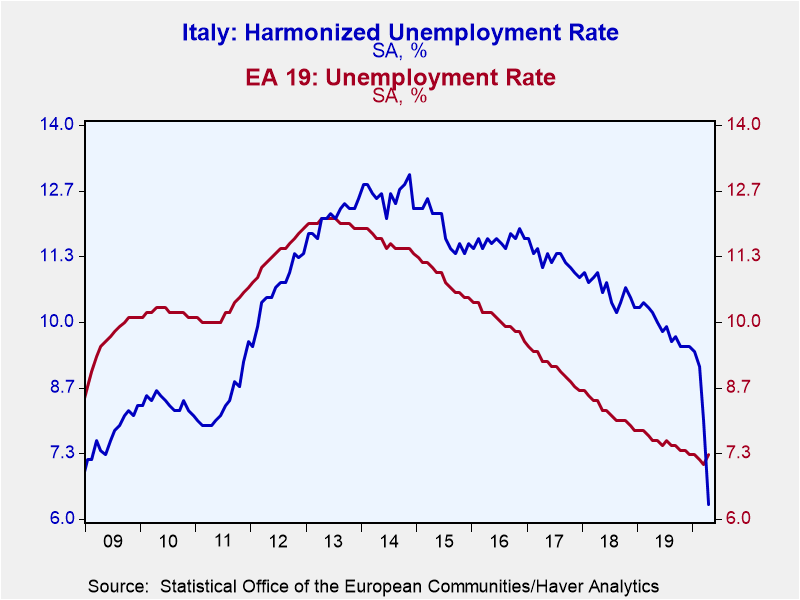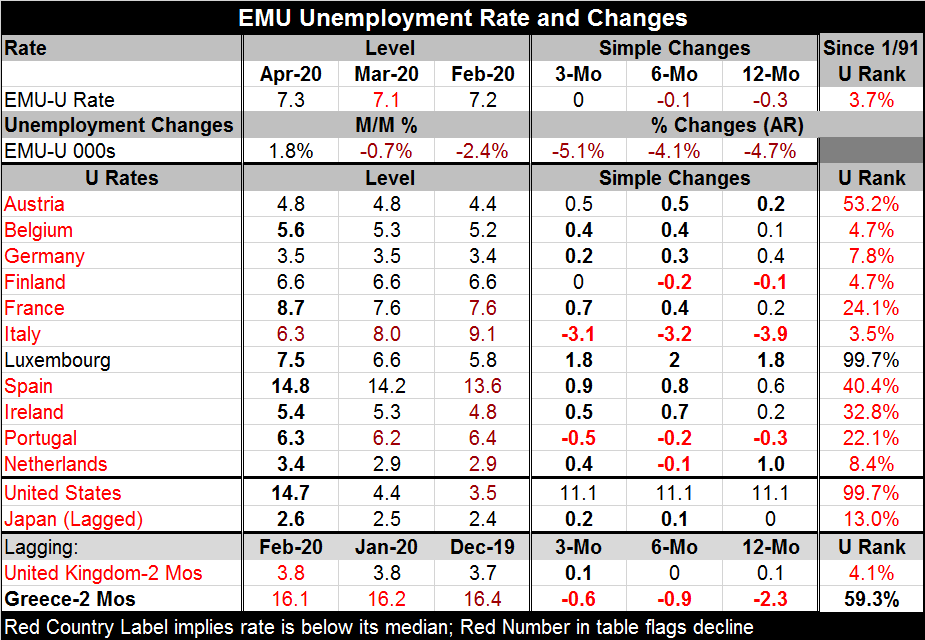 Global| Jun 03 2020
Global| Jun 03 2020Euro Area Unemployment Rate Falls; Italy's Rate Hits a 12-Year Low!
Summary
Unemployment rates in the U.S. economy have been a matter of controversy for some time. This month the data from Europe are eye opening and it reminds us why we need to think about what economic data mean as well as to report them and [...]
 Unemployment rates in the U.S. economy have been a matter of controversy for some time. This month the data from Europe are eye opening and it reminds us why we need to think about what economic data mean as well as to report them and move on. The Italian unemployment rate fell to a 12-year low at a time that economists were expecting the rate to spike higher. Economists often get the level of variables wrong but predicting the wrong direction for change (and with a massive error to boot) is truly embarrassing.
Unemployment rates in the U.S. economy have been a matter of controversy for some time. This month the data from Europe are eye opening and it reminds us why we need to think about what economic data mean as well as to report them and move on. The Italian unemployment rate fell to a 12-year low at a time that economists were expecting the rate to spike higher. Economists often get the level of variables wrong but predicting the wrong direction for change (and with a massive error to boot) is truly embarrassing.
However, in this case it is the Italian data that have gone rogue. For all of the EMU, the unemployment rate rose to 7.3% in April from 7.1% in March as the impact of coronavirus dislocations worked its way through the system. But in Italy, the unemployment rate in April plunged to 6.3% from 8.0%, a 12-year low. So how did Italy employ so many more people when the rest of Europe was reeling under the restrictions pertaining to reeling in the COVID-19? Nine of the thirteen countries in the table saw unemployment rates rise. However, Italy’s exceptional move lower came as the number unemployed in Italy also rose there but many more people in Italy simply stopped looking for work. And since they were not looking for work, they were no longer considered unemployed. Italy’s drop in the unemployment rate comes on a reduction in the size of the labor force and a sharp reduction in the number of jobseekers as well as an increase in the number unemployed.
Setting aside the Italian result, clearly labor markets weakened across Europe and Italy was actually part of that weakening. The unemployment rate slippage is much less in Europe than it has been in the U.S. on the same timeline. Over 12 months the EMU rate is still actually lower while the rate in the U.S. is higher by 11.1 percentage points.
The countries involved use different economic models. Within the EMU, there is one monetary policy, but many different labor-market polices as fiscal policy is conducted on a country level not EMU-wide. In each European nation across Europe, a number of workers have been kept home and their wages are in some way being sustained. But wage and income support is common across Europe as it is in the U.S. Still people fall through the cracks. And in each system, the impact on the unemployment rate is different.
For now European unemployment rates seem to be quite firm and low. The ranking of unemployment rates across the EMU are mostly below their medians (the 50th percentile standing). For the EMU overall, the rate has been lower only 3.7% of the time. Five EMU members have unemployment rate rankings in their lower 10th percentile. Only Austria and Luxembourg have rankings above their historic medians calculated on data back to 1991.
We will have to wait and see what kind of economic health all regions have as the steps to mitigate the virus pass and economies transition back to a full market mode. We are now in train for that process to take hold.

Robert Brusca
AuthorMore in Author Profile »Robert A. Brusca is Chief Economist of Fact and Opinion Economics, a consulting firm he founded in Manhattan. He has been an economist on Wall Street for over 25 years. He has visited central banking and large institutional clients in over 30 countries in his career as an economist. Mr. Brusca was a Divisional Research Chief at the Federal Reserve Bank of NY (Chief of the International Financial markets Division), a Fed Watcher at Irving Trust and Chief Economist at Nikko Securities International. He is widely quoted and appears in various media. Mr. Brusca holds an MA and Ph.D. in economics from Michigan State University and a BA in Economics from the University of Michigan. His research pursues his strong interests in non aligned policy economics as well as international economics. FAO Economics’ research targets investors to assist them in making better investment decisions in stocks, bonds and in a variety of international assets. The company does not manage money and has no conflicts in giving economic advice.






